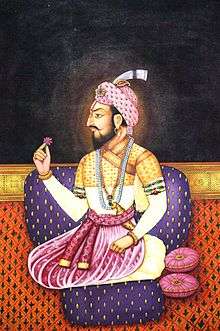Maratha Empire
| Maratha Empire Maratha Confederacy | ||||||||||||
| मराठा साम्राज्य | ||||||||||||
| ||||||||||||
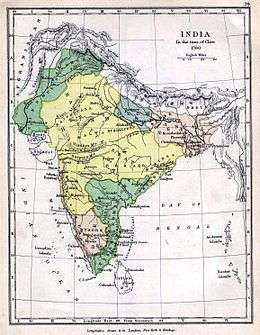 Territory under Maratha control in 1760 (yellow), without its vassals. | ||||||||||||
| Capital | Raigad (Maharashtra)
Gingee (Tamil Nadu)[1] Satara and Pune (Maharashtra) | |||||||||||
| Languages | Marathi, Sanskrit[2] | |||||||||||
| Religion | Hinduism | |||||||||||
| Government | Monarchy | |||||||||||
| Chhatrapati | ||||||||||||
| • | 1674–1680 | Shivaji (first) | ||||||||||
| • | 1808–1818 | Pratapsingh (last) | ||||||||||
| Peshwa | ||||||||||||
| • | 1674–1689 | Moropant Pingle (first) | ||||||||||
| • | 1795–1818 | Baji Rao II (last) | ||||||||||
| Legislature | Ashta Pradhan | |||||||||||
| History | ||||||||||||
| • | Deccan Wars | 6 June 1674 | ||||||||||
| • | Anglo-Maratha War | 20 February 1818 | ||||||||||
| Area | ||||||||||||
| 2,800,000 km² (1,081,086 sq mi) | ||||||||||||
| Population | ||||||||||||
| • | 1700 est. | Not known | ||||||||||
| Currency | Rupee, Paisa, Mohor, Shivrai, Hon | |||||||||||
| ||||||||||||
| Today part of | | |||||||||||
The Maratha Empire or the Maratha Confederacy was an Indian power that existed from 1674 to 1818 and ruled over much of the Indian sub-continent. The Marathas are credited to a large extent for ending the Mughal rule in India.[3][4][5]
The Marathas are the Hindu warrior group from the western Deccan Plateau (present day Maharashtra) that rose to prominence by establishing a Hindavi Swarajya. The Marathas became prominent in the 17th century under the leadership of Shivaji who revolted against the Adil Shahi dynasty and the Mughal Empire and carved out a rebel territory with Raigad as his capital. Known for their mobility, the Marathas were able to consolidate their territory during the Mughal–Maratha Wars and later controlled a large part of India.
Chhattrapati Shahu, a grandson of Shivaji, was released by the Mughals after the death of Emperor Aurangzeb. Following a brief struggle with his aunt Tarabai, Shahu became ruler and appointed Balaji Vishwanath, and later, his descendants, as the peshwas or prime ministers of the empire.[6] Balaji and his descendants played a key role in expansion of Maratha rule. The empire at its peak stretched from Tamil Nadu[7] in the south, to Peshawar (modern-day Khyber Pakhtunkhwa, Pakistan[8] [lower-alpha 1]) in the north, and Bengal and Andaman Islands in the east.[10] In 1761, the Maratha Army lost the Third Battle of Panipat to Ahmad Shah Abdali of the Afghan Durrani Empire which halted their imperial expansion into Afghanistan. Ten years after Panipat, the young Peshwa Madhavrao I's Maratha Resurrection reinstated Maratha authority over North India.
In a bid to effectively manage the large empire, he gave semi-autonomy to the strongest of the knights, which created a confederacy of Maratha states. They became known as the Gaekwads of Baroda, the Holkars of Indore and Malwa, the Scindias of Gwalior and Ujjain, the Bhonsales of the Nagpur and the Puars of Dhar and Dewas. In 1775, the East India Company intervened in a Peshwa family succession struggle in Pune, which became the First Anglo-Maratha War. The Marathas remained the preeminent power in India until their defeat in the Second Anglo-Maratha War which left the East India Company in control of most of India.
A large portion of the Maratha empire was coastline, which had been secured by the potent Maratha Navy under commanders such as Kanhoji Angre. He was very successful at keeping foreign naval ships, particularly of the Portuguese and British, at bay.[11] Securing the coastal areas and building land-based fortifications were crucial aspects of the Maratha's defensive strategy and regional military history.
Nomenclature
The Maratha Empire is also referred to as the Maratha Confederacy. The historian Barbara Ramusack says that the former is a designation preferred by Indian nationalists, while the latter was that used by British historians. She notes
Neither term is fully accurate since one implies a substantial degree of centralisation and the other signifies some surrender of power to a central government and a longstanding core of political administrators. Maratha power was fragmented among several discreet fragments. [12]
Although, at present the word Maratha refers to a particular caste of warriors and peasants, in the past the word has been used to describe Marathi people, including Marathas themselves.[13][14]
History
The empire had its head in the Chhatrapati as de jure but the de facto governance was in the hands of the Peshwas after death of Shahu and with the death of Madhavrao - I, various chiefs played the role of the de facto rulers in their own regions. The details are as below.
Shivaji and his descendants
Shivaji
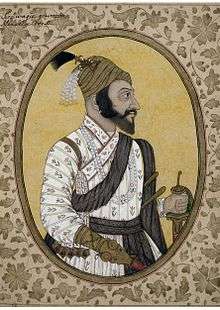
Shivaji was a Maratha aristocrat of the Bhosle clan who is considered to be the historical founder of the Maratha empire.[3] Shivaji led a resistance to free the Maratha people from the Sultanate of Bijapur, and re-establish Hindavi Swarajya ("self-rule of Hindu people"[15]). He created an independent Maratha kingdom with Raigad as its capital,[16] and successfully fought against the Mughals to defend his kingdom. He was crowned as Chhatrapati ("sovereign") of the new Maratha kingdom in 1674. The state as Shivaji founded it was a Maratha kingdom comprising about 4.1% of the subcontinent but spread over long tracts and dotted with forts about 300 at the time he died.[3] The cavalry was approx 40,000 and foot soldiers around 50,000 and naval establishments over west coast. Over time it was to increase in size and heterogeneity,[17] and by the time of the his grand son and later on under Peshwas in the early 18th century was a full-fledged empire.[18]
Sambhaji
Shivaji had two sons: Sambhaji and Rajaram. Sambhaji, the elder son, was very popular among the courtiers. In 1681, Sambhaji had himself crowned and resumed his father's expansionist policies. Sambhaji had earlier defeated the Portuguese and Chikka Deva Raya of Mysore. To nullify any Rajput-Maratha alliance, as well as the Deccan Sultanates, the Mughal emperor Aurangzeb himself headed south in 1681. With his entire imperial court, administration, and an army of about 500,000 troops he proceeded to build the empire, gaining territories such as the sultanates of Bijapur and Golconda. During the eight years that followed, Sambhaji led the Marathas, never losing a battle or a fort to Aurangzeb.
In early 1689, Sambhaji called his commanders for a strategic meeting at Sangameshwar to consider a final onslaught on the Mughal forces. In a meticulously planned operation, Ganoji Shirke and Aurangzeb's commander, Mukarrab Khan, attacked Sangameshwar when Sambhaji was accompanied by a few men. Sambhaji was ambushed and captured by Mughal troops on 1 February 1689. He and his advisor, Kavi Kalash, were taken to Bahadurgad, where they were executed for rebellion against the Mughals on 11 March 1689.
Rajaram and Tarabai
Upon Sambhaji's death, Rajaram, his half-brother, assumed the throne. The Mughal siege of Raigad continued and he had to flee to Vishalgad and then to Gingee for safety. From there the Marathas raided Mughal territory and many forts were recaptured by Maratha commanders such as Santaji Ghorpade, Dhanaji Jadhav, Parshuram Pant Pratinidhi, Shankaraji Narayan Sacheev, and Melgiri Pandit. In 1697, Rajaram offered a truce but this was rejected by Aurangzeb. Rajaram died in 1700 at Sinhagad. His widow, Tarabai, assumed control in the name of her son, Ramaraja (Shivaji II). She led the Marathas against the Mughals and by 1705 they had crossed the Narmada River and entered Malwa, then in Mughal possession.
Shahu
After Aurangzeb's death in 1707, Shahuji, son of Sambhaji (and grandson of Shivaji), was released by Bahadur Shah I, the new Mughal emperor but his mother was kept a hostage of the Mughals in order to ensure that Shahuji adhered to the release conditions. Upon release, Shahu immediately claimed the Maratha throne and challenged his aunt Tarabai and her son. This promptly turned the now-spluttering Mughal-Maratha war into a three-cornered affair. The states of Satara and Kolhapur came into being in 1707, because of the succession dispute over the Maratha kingship. However, Shahu was finally accepted as Chhatrapati of the Marathas.[19] His mother was still held captive and he could only obtain her release in 1719 when the Marathas became strong enough.
Shahu appointed the Balaji Vishwanath as Peshwa.[20] During regime of Shahu, Raghuji Bhosale expanded the empire in East reaching present-day Bengal. Senapati Dabhade expanded in West. Peshwa Bajirao and his three chiefs Pawar(Dhar), Holkar (Indore) and Scindia (Gwalior) expanded in North. All these houses became hereditary, thereby eventually undermining the Chhatrapati's authority there.
Peshwa era
During this era, Peshwas belonging to the (Bhat) Chitpavan family controlled the Maratha Army and later became de facto rulers of the Maratha Empire. During their reign, the Maratha empire reached its zenith ruling most of the Indian subcontinent.
Balaji Vishwanath

Shahu appointed the Peshwa Balaji Vishwanath in 1713. From his time, the office of Peshwa became supreme while Shahuji became a figure head.[20]
- His first major achievement was the conclusion of the Treaty of Lanavala in 1714 with Kanhoji Angre, the most powerful naval chief on the Western Coast. He later joined the Marathas.
- In 1719, an army of Marathas marched up to Delhi along with Sayyid Hussain Ali, the Mughal governor of Deccan and managed to depose the Mughal emperor. Thus, Marathas realised for the first time their potential to "make and unmake" Mughal Emperors.[21]
Baji Rao I

After Balaji Vishwanath's death in April 1720, his son, Baji Rao I, was appointed Peshwa by Shahu. Bajirao is credited with expanding the Maratha Empire tenfold from 3% to 30% of the modern Indian landscape during 1720–40. He fought over 41 battles before his death in 1740 and is reputed to have never lost one.[22]
- The Battle of Palkhed was a land battle that took place on 28 February 1728 at the village of Palkhed, near the city of Nashik, Maharashtra, India between Baji Rao I and the Nizam-ul-Mulk of Hyderabad. The Marathas defeated the Nizam.The battle is considered an example of brilliant execution of military strategy.[23]
- In 1737, Marathas under Bajirao I raided the suburbs of Delhi in a blitzkrieg in the Battle of Delhi (1737).[24][25]
- The Nizam left Deccan to rescue Mughals from the invasion of Marathas, but was defeated decisively in the Battle of Bhopal.[25][26] The Marathas extracted large tributaries from Mughals and signed a treaty which ceded Malwa to the Marathas.[27]
- The Battle of Vasai was fought between the Marathas and the Portuguese rulers of Vasai, a village lying on northern shore of Vasai creek, 50 km north of Mumbai. The Marathas were led by Chimaji Appa, a brother of Baji Rao. Maratha victory in this war was a major achievement of Baji Rao's time in office.[25]
Balaji Baji Rao

Baji Rao's son, Balaji Bajirao (Nanasaheb), was appointed as the next Peshwa by Shahuji despite opposition of other chiefs
- In 1740, the Maratha forces came down upon Arcot and defeated the Nawab of Arcot, Dost Ali, in the pass at Damalcherry. In the war that followed, Dost Ali, one of his sons Hasan Ali, and a number of other prominent persons lost their lives. This initial success at once enhanced Maratha prestige in the south. From Damalcherry, the Marathas proceeded to Arcot, which surrendered to them without much resistance. Then, Raghuji invaded Trichinopoly in December 1740. Unable to resist, Chanda Saheb surrendered the fort to Raghuji on 14 March 1741. Chanda Saheb and his son were arrested and sent to Nagpur.[28]
- After the successful campaign of Karnatak and the Battle of Trichinopolly, Raghuji returned from Karnatak. He undertook six expeditions in Bengal from 1741 to 1748.[29] Raghuji was able to annex Odisha to his kingdom permanently as he successfully exploited the chaotic conditions prevailing in Bengal, Bihar and Odisha after the death of their Governor, Murshid Quli Khan, in 1727. Constantly harassed by the Bhonsles, Odisha or Cuttack, Bengal and parts of Bihar were economically ruined. Alivardi Khan, Nawab of Bengal made peace with Raghuji in 1751 ceding in perpetuity Cuttack up to the river Subarnarekha, and agreeing to pay Rs.1.2 million annually in lieu of the Chauth of Bengal and Bihar.[30]
- Rajputana also came under Maratha domination during this time.[30]
- Balaji Bajirao encouraged agriculture, protected the villagers, and brought about a marked improvement in the state of the territory. Continued expansion saw Raghunath Rao, the brother of Nanasaheb, pushing into in the wake of the Afghan withdrawal after Ahmed Shah Abdali's plunder of Delhi in 1756. Delhi was captured by Maratha army under Raghunath Rao in August 1757 defeating Afghan garrison in the Battle of Delhi. This laid the foundation for the Maratha conquest of North-west India. In Lahore, as in Delhi, the Marathas were now major players.[31] After Battle of Attock, 1758, the Marathas captured Peshawar defeating the Afghan troops in the Battle of Peshawar on 8 May 1758.[8] As noted by J.C. Grant Duff:
The pre-eminence to which the Mahrattas had attained was animating and glorious; their right to tribute was acknowledged on the banks of the Coleroon (the lower Kaveri in Tamil Nadu), and the Deccan horse had quenched their thirst from the waters of the Indus.[32]
Maratha invasion of Delhi and Rohilkhand
Just prior to the battle of Panipat in 1761, Marathas looted "Diwan-i-Khas" or 'Hall of Private Audiences' in the Red Fort of Delhi, which was the place where the Mughal emperors used to receive courtiers and state guests, in one of their expeditions of Delhi.
The Marathas who were hard pressed for money stripped the ceiling of Diwan-i-Khas of its silver and looted the shrines dedicated to Muslim saints.[33]
During the Maratha invasion of Rohilkhand in the 1750s
The Marathas defeated the Rohillas, forced them to seek shelter in hills and ransacked their country in such a manner that the Rohillas dreaded the Marathas and hated them ever afterwards.[33]
Third battle of Panipat
In 1759, The Marathas under Sadashivrao Bhau (referred to as the Bhau or Bhao in sources) responded to the news of the Afghans' return to North India by sending a big army to North. Bhau's force was bolstered by some Maratha forces under Holkar, Scindia, Gaikwad and Govind Pant Bundele. The combined army of over 100,000 regular troops had re-captured the former Mughal capital, Delhi, from an Afghan garrison in August 1760.[34] Delhi had been reduced to ashes many times due to previous invasions, and in addition there being acute shortage of supplies in the Maratha camp. Bhau ordered the sacking of the already depopulated city.[33][35] He is said to have planned to place his nephew and the Peshwa's son, Vishwasrao, on the Mughal throne. By 1760, with defeat of the Nizam in the Deccan, Maratha power had reached its zenith with a territory of over 2,800,000 km² acres.
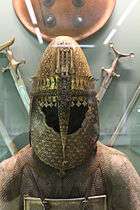
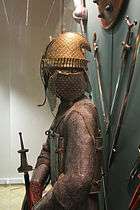
Ahmad Shah Durrani, then called Rohillas and Nawab of Oudh to assist him in driving out 'infidel' Marathas from Delhi. Huge armies of Muslim forces and Marathas collided with each other on 14 January 1761 in the Third Battle of Panipat. The Maratha Army lost the battle which halted imperial expansion. The Jats and Rajputs did not support the Marathas. Their withdrawal from the ensuing battle played a crucial role in its result. Hindutva-sympathising historians have criticised the Maratha treatment of fellow Hindu groups. Kaushik Roy says "The treatment of Marathas with their co-religionist fellows – Jats and Rajputs was definitely unfair, and ultimately they had to pay its price in Panipat where Muslim forces had united in the name of religion."[31] The Marathas had antagonised the Jats and Rajputs by taxing them heavily, punishing them after defeating the Mughals and interfering in their internal affairs. The Marathas were abandoned by Raja Suraj Mal of Bharatpur and the Rajputs who quit the Maratha alliance at Agra before the start of the great battle and withdrew their troops, as Maratha general Sadashivrao Bhau did not heed the advice to leave soldier's families (women and children) and pilgrims at Agra and not take them to the battle field with the soldiers, rejected their co-operation. Their supply chains (earlier assured by Raja Suraj Mal and Rajputs) did not exist.
Peshwa Madhav Rao I
Peshwa Madhavrao I was the fourth Peshwa of the Maratha Empire. It was during his tenure that the Maratha Resurrection took place. He worked as a unifying force in the Maratha Empire and moved to the south to subdue Nizam and Mysore to assert Maratha power. He sent generals such as Bhonsle, Scindia, and Holkar to the north, where they re-established Maratha authority by the early 1770s.
Prof G.S.Chhabra wrote:
Young though he was, Madhav Rao had a cool and calculating head of a seasoned and experienced man. The diplomacy by which he could win over his uncle Raghoba when he had no strength to fight, and the way he could crush his power when he had the means to do so later on proved in him a genius who knows when and how to act. The formidable power of the Nizam was crushed, Hyder Ali who was a terror even to the british was effectually humbled, and before he died in 1772, the Marathas were almost there in the north where they had been before Panipat. What could not have the Marathas achieved if Madhav had continued living just for a few years more? Destiny was not in favour of the Marathas, the death of Madhav was a greater blow than their defeat of Panipat, and from this blow they could never again recover.[36]
His death is considered to be the most fatal blow to the Maratha Empire and from that time Maratha power started to move on a downward trajectory with working as a confederacy than an empire. He died at the age of 27 in 1772.
Confederacy era
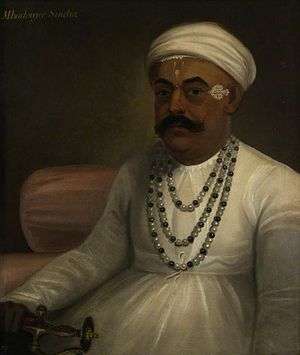
In a bid to effectively manage the large empire, Madhavrao Peshwa gave semi-autonomy to the strongest of the knights. After the death of Peshwa Madhavrao I, various chiefs and statesman became de facto rulers and the Peshwa was relegated to a secondary position and became the ceremonial king. Thus, the semi-autonomous Maratha states came into being in far-flung regions of the empire:
- Peshwas of Pune
- Gaekwads of Baroda
- Holkars of Indore
- Scindias(aka Shindes) of Gwalior (Chambal region) and Ujjain (Malwa Region).
- Bhonsales of Nagpur (no blood relation with Shivaji's or Tarabai's family)
- Puars (or Pawars) of Dewas & Dhar
- Even in the original kingdom of Shivaji itself, many knights were given semi-autonomous charges of small districts, which led to princely states Sangli, Aundh, Bhor, Bawda, Phaltan, Miraj, etc. Pawars of Udgir were also part of confederacy.
Major events
- After the 1761 Battle of Panipat, Malhar Rao Holkar attacked the Rajputs and defeated them at the battle of Mangrol. This largely restored Maratha power in Rajasthan.[37]
- Under the leadership of Mahadji Shinde, the ruler of the state of Gwalior in central India, the Marathas defeated the Jats, the Rohilla Afghans and took Delhi which remained under Maratha control for the next three decades.[38] His forces conquered modern day Haryana[39] Shinde was instrumental in resurrecting Maratha power after the débâcle of the Third Battle of Panipat, and in this he was assisted by Benoît de Boigne.
- In 1767 Madhavrao I crossed the Krishna River and defeated Hyder Ali in the battles of Sira and Madgiri. He also rescued the last queen of the Keladi Nayaka Kingdom, who had been kept in confinement by Hyder Ali in the fort of Madgiri.[40]
- In early 1771, ten years after the collapse of Maratha authority over North India following the Third Battle of Panipat, Mahadji recaptured Delhi and installed Shah Alam II as a puppet ruler on the Mughal throne.[41] receiving in return the title of deputy Vakil-ul-Mutlak or vice-regent of the Empire and that of Vakil-ul-Mutlak being at his request conferred on the Peshwa. The Mughals also gave him the title of Amir-ul-Amara (head of the amirs).[42]
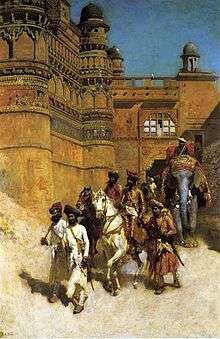
- After taking control of Delhi, the Marathas sent a large army in 1772 to "punish" Afghan Rohillas for their involvement in Panipat. Their army devastated Rohilkhand by looting and plundering, as well as taking members of the royal family as captives.[41]
- After the growth in power of feudal lords like Malwa sardars, landlords of Bundelkhand and Rajput kingdoms of Rajasthan, they refused to pay tribute to Mahadji. So he sent his army conquer the states such as Bhopal, Datiya, Chanderi, Narwar, Salbai and Gohad. However, he launched an unsuccessful expedition against the Raja of Jaipur, but withdrew after the inconclusive Battle of Lalsot in 1787.[43]
- The Battle of Gajendragad was fought between the Marathas under the command of Tukojirao Holkar (the adopted son of Malharrao Holkar) and Tipu Sultan from March 1786 to March 1787 in which Tipu Sultan was defeated by the Marathas. By the victory in this battle, the border of the Maratha territory extended till Tungabhadra river.[44]
- The strong fort of Gwalior was then in the hands of Chhatar Singh, the Jat ruler of Gohad. In 1783, Mahadji besieged the fort of Gwalior and conquered it. He delegated the administration of Gwalior to Khanderao Hari Bhalerao. After celebrating the conquest of Gwalior, Mahadji Shinde turned his attention to Delhi again.[45]
- In 1788 Mahadji's armies defeated Ismail Beg, a Mughal noble who resisted the Marathas.[46] The Rohilla chief Ghulam Kadir, Ismail Beg's ally, took over Delhi, capital of the Mughal dynasty, and deposed and blinded the king Shah Alam II, placing a puppet on the Delhi throne. Mahadji intervened and killed him, taking possession of Delhi on 2 October, restoring Shah Alam II to the throne and acting as his protector.[47]
- Jaipur and Jodhpur, the two most powerful Rajput states, were still out of direct Maratha domination. So, Mahadji sent his general Benoît de Boigne to crush the forces of Jaipur and Jodhpur at the Battle of Patan.[48] Marwar was also captured on 10 September 1790.
- Another achievement of the Marathas was their victories over the Nizam of Hyderabad's armies including in the Battle of Kharda.[49][50]
British intervention
In 1775, the British East India Company, from its base in Bombay, intervened in a succession struggle in Pune, on behalf of Raghunathrao (also called Raghobadada) who wanted to become Peshwa of the empire. Marathas forces under Tukojirao Holkar and Mahadaji Shinde defeated a British expeditionary force at the battle of Vadgaon, but the heavy surrender terms, which included the return of annexed territory and a share of revenues, were disavowed by the British authorities at Bengal and fighting continued. What became known as the First Anglo-Maratha War ended in 1782 with a restoration of the pre-war status quo and the East India Company's abandonment of Raghunathrao's cause.[51]

In 1799, Yashwantrao Holkar was crowned King of Holkars, he captured Ujjain. He started campaigning towards the north to expand his empire in that region. Yashwant Rao rebelled against the policies of the Peshwa Baji Rao II. In May 1802, he marched towards Pune the seat of the Peshwa. This gave rise to the Battle of Poona in which the Peshwa was defeated. After the Battle of Poona, the flight of Peshwa left the government of Maratha state in the hands of Yashwantrao Holkar.[52] He appointed Amrutrao as the Peshwa and went to Indore on 13 March 1803. All except Gaikwad chief of Baroda, who had already accepted British protection by a separate treaty on 26 July 1802, supported the new regime. He made a treaty with the British. Also, Yashwant-Rao successfully resolved the disputes with Scindia and the Peshwa. He tried to unite the Maratha Confederacy but to no avail. In 1802 the British intervened in Baroda to support the heir to the throne against rival claimants, and they signed a treaty with the new Maharaja recognising his independence from the Maratha Empire in return for his acknowledgement of British paramountcy. Before the Second Anglo-Maratha War (1803–1805), the Peshwa Baji Rao II signed a similar treaty. The defeat in Battle of Delhi, 1803 during Second Anglo-Maratha War resulted in the loss of the city of Delhi for the Marathas.[53]
The Second Anglo-Maratha War represents the military high-water mark of the Marathas who posed the last serious opposition to the formation of the British Raj. The real contest for India was never a single decisive battle for the subcontinent. Rather it turned on a complex social and political struggle for control of the South Asian military economy. The victory in 1803 hinged as much on finance, diplomacy, politics and intelligence as it did on battlefield manoeuvre and war itself.[54]
%2C_c._1815..jpg)
Ultimately, the Third Anglo-Maratha War (1817–1818) resulted in the loss of Maratha independence. It left the British in control of most of India. The Peshwa was exiled to Bithoor (Maratnear Kanpur, Uttar Pradesh) as a pensioner of the British. The Maratha heartland of Desh, including Pune, came under direct British rule, with the exception of the states of Kolhapur and Satara, which retained local Maratha rulers. The Maratha-ruled states of Gwalior, Indore, and Nagpur all lost territory, and came under subordinate alliance with the British Raj as princely states that retained internal sovereignty under British 'paramountcy'. Other small princely states of Maratha knights were retained under the British Raj as well.
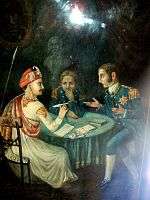
The Third Anglo-Maratha War was fought by Maratha war lords separately instead of forming a common front and they surrendered one by one. Shinde and the Pashtun Amir Khan were subdued by the use of diplomacy and pressure, which resulted in the Treaty of Gwailor[55] on 5 November 1817. All other Maratha chiefs like Holkars, Bhonsles and Peshwa gave up arms by 1818. British historian Percival Spear describes 1818 as a watershed year in the history of India, saying that by the year "the British dominion in India became the British dominion of India".[56][57]
The war left the British, under the auspices of the British East India Company, in control of virtually all of present-day India south of the Sutlej River. The famed Nassak Diamond was acquired by the Company as part of the spoils of the war.[58] The British acquired large chunks of territory from the Maratha Empire and in effect put an end to their most dynamic opposition.[59] The terms of surrender Major-general John Malcolm offered to the Peshwa were controversial amongst the British for being too liberal: The Peshwa was offered a luxurious life near Kanpur and given a pension of about 80,000 pounds. A comparison was drawn with Napoleon, who was confined to a small rock in the south Atlantic and given a small sum for his maintenance.
Administration

The Ashtapradhan (The Council of Eight) was a council of eight ministers that administered the Maratha empire.[60] Ministerial designations were drawn from the Sanskrit language and comprised:
- Pantpradhan or Peshwa – Prime Minister, general administration of the Empire.
- Amatya or Mazumdar – Finance Minister, managing accounts of the Empire.[61]
- Sacheev – Secretary, preparing royal edicts.
- Mantri – Interior Minister, managing internal affairs especially intelligence and espionage.
- Senapati – Commander-in-Chief, managing the forces and defence of the Empire.
- Sumant – Foreign Minister, to manage relationships with other sovereigns.
- Nyayadhish – Chief Justice, dispensing justice on civil and criminal matters.
- Panditrao – High Priest, managing internal religious matters.
With the notable exception of the priestly Panditrao and the judicial Nyayadisha, the other pradhans held full-time military commands and their deputies performed their civil duties in their stead. In the later era of the Maratha Empire, these deputies and their staff constituted the core of the Peshwa's bureaucracy.
The Peshwa was the titular equivalent of a modern Prime Minister. Shivaji created the Peshwa designation in order to more effectively delegate administrative duties during the growth of the Maratha Empire. Prior to 1749, Peshwas held office for 8–9 years and controlled the Maratha Army. They later became the de facto hereditary administrators of the Maratha Empire from 1749 till its end in 1818.
Under Peshwa administration and with the support of several key generals and diplomats (listed below), the Maratha Empire reached its zenith, ruling most of the Indian subcontinent. It was also under the Peshwas that the Maratha Empire came to its end through its formal annexation into the British Empire by the British East India Company in 1818.

The Marathas used secular policy of administration and allowed complete freedom of religion.[62] There were many notable Muslims in the military and administration of Marathas like Ibrahim Khan Gardi, Haider Ali Kohari, Daulat Khan, Siddi Ibrahim, and Jiva Mahal.
Shivaji was an able administrator who established a government that included modern concepts such as cabinet, foreign policy and internal intelligence. He established an effective civil and military administration. He believed that there was a close bond between the state and the citizens. He is remembered as a just and welfare-minded king. Cosme da Guarda says of him that:[63]
Such was the good treatment Shivaji accorded to people and such was the honesty with which he observed the capitulations that none looked upon him without a feeling of love and confidence. By his people he was exceedingly loved. Both in matters of reward and punishment he was so impartial that while he lived he made no exception for any person; no merit was left unrewarded, no offence went unpunished; and this he did with so much care and attention that he specially charged his governors to inform him in writing of the conduct of his soldiers, mentioning in particular those who had distinguished themselves, and he would at once order their promotion, either in rank or in pay, according to their merit. He was naturally loved by all men of valor and good conduct.
However, the later Marathas are remembered more for their military campaigns, not for their administration.
Geography
The Maratha Empire, at its peak, ruled over a large area in the Indian sub-continent. Apart from capturing various regions, the Marathas maintained a large number of tributaries who were bounded by agreement to pay a certain amount of regular tax, known as "Chauth". The empire defeated the Sultanate of Mysore under Hyder Ali and Tipu Sultan, the Nawab of Oudh, the Nawab of Bengal, Nizam of Hyderabad and Nawab of Arcot as well as the Polygar kingdoms of South India. They extracted chauth from Delhi, Oudh, Bengal, Bihar, Odisha, Punjab, Hyderabad, Mysore, Uttar Pradesh and Rajputana.[64][65]
The Marathas were requested by Safdarjung, the Nawab of Oudh, in 1752 to help him defeat Afghani Rohilla. The Maratha force left Poone and defeated Afghan Rohilla in 1752, capturing the whole of Rohilkhand (present-day northwestern Uttar Pradesh).[33] In 1752, Marathas entered into an agreement with the Mughal emperor, through his wazir, Safdarjung, Mughals gave the Marathas the chauth of the Punjab, Sindh and the Doab in addition to the subedari of Ajmer and Agra.[66] In 1758, the Marathas started their north-west conquest and expanded their boundary till Afghanistan. They defeated Afghan forces of Ahmed Shah Abdali, in what is now Pakistan, including Pakistani Punjab Province and Khyber Pakhtunkhwa. The Afghans were numbered around 25,000–30,000 and were led by Timur Shah, the son of Ahmad Shah Durrani. The Marathas massacred and looted thousands of Afghan soldiers and captured Lahore, Multan, Dera Ghazi Khan, Attock, Peshawar in the Punjab region and Kashmir.[67][68]
During the confederacy era, Mahadji Sindhia resurrected the Maratha domination on much of North India, which was lost after the Third battle of Panipat including the cis-Sutlej states (south of Sutlej) like Kaithal, Patiala, Jind, Thanesar, Maler Kotla, and Faridkot, Delhi and Uttar Pradesh were under the suzerainty of the Scindhia dynasty of the Maratha Empire, following the Second Anglo-Maratha War of 1803–1805, Marathas lost these territories to the British East India Company.[42][69]
Legacy
Navy

The Maratha Empire is credited with laying the foundation of the Indian Navy and bringing about considerable changes in naval warfare by introducing a blue-water navy. From its inception in 1674, the Marathas established a naval force, consisting of cannons mounted on ships. The 'Pal' was a three-masted Maratha man-of-war with guns on its broadsides.
The dominance of the Maratha Navy started with the ascent of Kanhoji Angre as the Darya-Saranga by the Maratha chief of Satara.[70] Under that authority, he was admiral of the Western coast of India from Bombay to Vingoria (now Vengurla) in the present day state of Maharashtra, except for Janjira which was affiliated with the Mughal Empire.
The Marathas established watch posts on the Andaman Islands and are credited with attaching those islands to India.[10] He attacked English, Dutch and Portuguese ships which were moving to and from East Indies. Until his death in 1729, he repeatedly attacked the colonial powers of Britain and Portugal, capturing numerous vessels of the British East India Company and extracting ransom for their return.
On 29 November 1721, a joint attempt by the Portuguese Viceroy Francisco José de Sampaio e Castro and the British General Robert Cowan to humble Kanhoji failed miserably. Their combined fleet consisted of 6,000 soldiers in no less than four Man-of-war besides other ships led by Captain Thomas Mathews of the Bombay Marine. Aided by the Maratha naval commanders Mendhaji Bhatkar and Mainak Bhandari, Kanhoji continued to harass and plunder the European ships until his death in 1729.
Accounts by Afghans and Europeans
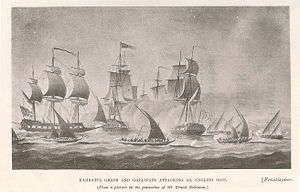
The Maratha army, especially its infantry, was praised by almost all the enemies of Maratha Empire, ranging from Duke of Wellington to Ahmad Shah Abdali. After the Third Battle of Panipat, Abdali was relieved as Maratha army in the initial stages were almost in the position of destroying the Afghan armies and their Indian Allies Nawab of Oudh and Rohillas. The grand wazir of Durrani Empire, Shah Wali Khan was shocked when Maratha commander-in-chief Sadashivrao Bhau launched a fierce assault on the centre of Afghan Army, over 3,000 Durrani soldiers were killed alongside Haji Atai Khan, one of the chief commander of Afghan army and nephew of wazir Shah Wali Khan. Such was the fierce assault of Maratha infantry in hand-to-hand combat that Afghan armies started to flee and the wazir in desperation and rage shouted "Comrades Whither do you fly, our country is far off".[71] Post battle Ahmad Shah Abdali in a letter to one Indian ruler claimed that Afghans were able to defeat the Marathas only because of the blessings of almighty and any other army would have been destroyed by the Maratha army on that particular day even though Maratha army was numerically inferior to Afghan army and its Indian allies.[72] Though Abdali won the battle, he also had heavy casualties on his side. So, he sought immediate peace with the Marathas. Abdali wrote in his letter to Peshwa on 10 February 1761:
There is no reason to have animosity amongst us. Your son Vishwasrao and your brother Sadadhivrao died in battle, was unfortunate. Bhau started the battle, so I had to fight back unwillingly. Yet I feel sorry for his death. Please continue your guardianship of Delhi as before, to that I have no opposition. Only let Punjab until Sutlaj remain with us. Reinstate Shah Alam on Delhi's throne as you did before and let there be peace and friendship between us, this is my ardent desire. Grant me that desire.[73]

Similarly, Duke of Wellington after defeating Marathas noted that Marathas, though poorly led by their Generals, had regular infantry and artillery that matched the level of that of the Europeans and warned other British officers from underestimating the Marathas in battlefield. He cautioned one British general that: "You must never allow Maratha infantry to attack head on or in close hand to hand combat, as in that your army will cover itself with utter disgrace".[74] Even when Arthur Wellesley, 1st Duke of Wellington, became the Prime Minister of Britain, he held Maratha infantry in utmost respect, claiming it to be one of the best in world. However, at the same time he noticed the poor leadership of Maratha Generals, who were often responsible for their defeats.[74] Charles Metcalfe, one of the ablest of the British Officials in India and later acting Governor-General, wrote in 1806:
India contains no more than two great powers, British and Mahratta, and every other state acknowledges the influence of one or the other. Every inch that we recede will be occupied by them.[75][76]
Norman Gash says that the Maratha infantry was equal to that of British infantry. After the Third Anglo-Maratha war in 1818, Britain listed the Marathas as one of the Martial races to serve in British Indian Army.[77]
Notable generals and administrators
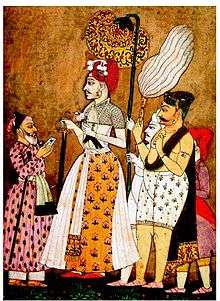
Ramchandra Pant Amatya Bawdekar
Ramchandra Pant Amatya Bawdekar was a court administrator who rose from the ranks of a local Kulkarni to the ranks of Ashtapradhan under guidance and support of Shivaji. He was one of the prominent Peshwas from the time of Shivaji, prior to the rise of the later Peshwas who controlled the empire after Shahuji.[60]
When Rajaram fled to Jinji in 1689 leaving Maratha Empire, he gave a "Hukumat Panha" (King Status) to Pant before leaving. Ramchandra Pant managed the entire state under many challenges like influx of Mughals, betrayal from Vatandars (local satraps under the Maratha state) and social challenges like scarcity of food. With the help of Pantpratinidhi, Sachiv, he kept the economic condition of Maratha Empire in an appropriate state.
He received military help from the Maratha commanders – Santaji Ghorpade and Dhanaji Jadhav. On many occasions he himself participated in battles against Mughals.
In 1698, he stepped down from the post of "Hukumat Panha" when Rajaram offered this post to his wife, Tarabai. Tarabai gave an important position to Pant among senior administrators of Maratha State. He wrote "Adnyapatra" (मराठी: आज्ञापत्र) in which he has explained different techniques of war, maintenance of forts and administration etc. But owing to his loyalty to Tarabai against Shahuji (who was supported by more local satraps), he was sidelined after arrival of Shahuji in 1707.
Nana Phadnavis
Nana Phadnavis was an influential minister and statesman of the Maratha Empire during the Peshwa administration. Nana Phadnavis played a pivotal role in holding the Maratha Confederacy together in the midst of internal dissension and the growing power of the British. Nana's administrative, diplomatic and financial skills brought prosperity to the Maratha Empire and his management of external affairs kept the Maratha Empire away from the thrust of the British East India Company. After the assassination of Peshwa Narayanrao in 1773, Nana Phadnavis managed the affairs of the state with the help of a twelve-member regency council known as the Barbhai council and he remained the chief strategist of Maratha state till his death in 1800 AD.[78]
Personalities
Royal Houses
Satara:
- Shahu I (r.1708 - 1749) (alias Shivaji II, son of Chhatrapati Sambhaji)
- Ramaraja II (nominally, grandson of Chhatrapati Rajaram and Queen Tarabai) (r.1749 - 1777)
- Shahu II (r.1777 - 1808)
- Pratap Singh (r.1808 - 1839) - Signed a treaty with the East India company ceding part of sovereignty to the company[79]
Kolhapur:
- Queen Tarabai (1675–1761) (wife of Chhatrapati Rajaram) in the name of her son Shivaji II
- Shivaji II (1700–1714)
- Shivaji III (1760–1812) (adopted from the family of Khanwilkar)
Peshwas

- Moropant Trimbak Pingle (1657–1683)
- Bahiroji Pingale (1708–1711)
Peshwas from the Bhat family
From Balaji Vishwanath onwards, actual power gradually shifted to the Bhat family Peshwas based in Pune.
- Balaji Vishwanath (1713–1720)
- Peshwa Bajirao I (1720–1740)
- Balaji Bajirao (4 Jul.1740-23 Jun.1761) (b. 8 Dec. 1721, d. 23 Jun.1761)
- Madhavrao Peshwa (1761–18 Nov.1772) (b. 16 Feb 1745, d. 18 Nov 1772)
- Narayanrao Bajirao (13 Dec. 1772–30 Aug.1773) (b. 10 Aug.1755, d. 30 Aug.1773)
- Raghunathrao (5 Dec. 1773–1774) (b. 18 Aug.1734, d. 11 Dec. 1783)
- Sawai Madhava Rao II Narayan (1774–27 Oct.1795) (b. 18 Apr.1774, d. 27 Oct.1795)
- Baji Rao II (6 Dec. 1796 – 3 Jun.1818) (d. 28 Jan.1851)
Chieftains
- Holkars of Indore
- Shindes of Gwalior
- Gaikwads of Baroda
- Bhonsales of Nagpur
- Puarss of Dewas and Dhar
Maps showing the Maratha Empire at different stages of history
 Maratha kingdom in 1680 (green)
Maratha kingdom in 1680 (green)- Maratha Empire at its peak in 1758 (orange)
 Maratha Empire in 1760 (yellow)
Maratha Empire in 1760 (yellow) Maratha Empire in 1765 (yellow)
Maratha Empire in 1765 (yellow)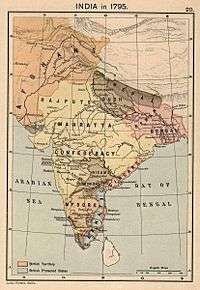 Maratha Empire in 1794 (yellow)
Maratha Empire in 1794 (yellow)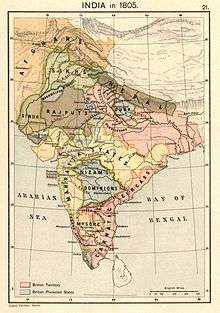 Maratha Empire in 1805 (yellow)
Maratha Empire in 1805 (yellow)
Thanjavur Maratha Kingdom (Tamil Nadu)
Thanjavur Marathas were the rulers of Thanjavur principality of Tamil Nadu between the 17th to the 19th century. Their native language was Thanjavur Marathi. Venkoji was the founder of the dynasty.
Thanjavur Maratha dynasty :
See also
| Wikimedia Commons has media related to Maratha Empire. |
- Marathi People
- Maratha Navy
- List of Maratha dynasties and states
- Maratha War of Independence
- Battles involving the Maratha Empire
- Maratha Army
- Maratha titles
- Thanjavur Maratha kingdom
- Military history of India
- List of people involved in the Maratha Empire
Notes
Citations
- ↑ https://books.google.co.in/books?id=oUTRAAAAMAAJ
- ↑ Majumdar, R.C. (ed.) (2007). The Mughul Empire, Mumbai: Bharatiya Vidya Bhavan, ISBN 81-7276-407-1, pp. 609, 634.
- 1 2 3 Pearson, M. N. (February 1976). "Shivaji and the Decline of the Mughal Empire". The Journal of Asian Studies. 35 (2): 221–235. doi:10.2307/2053980. JSTOR 2053980. (subscription required (help)).
- ↑ Delhi, the Capital of India By Anon, John Capper, p.28. "This source establishes the Maratha control of Delhi before the British"
- ↑ An Advanced History of Modern India By Sailendra Nath Sen p.Introduction-14. The author says: "The victory at Bhopal in 1738 established Maratha dominance at the Mughal court"
- ↑ The Journal of Asian Studies The Journal of Asian Studies / Volume 21 / Issue 04 / August 1962, pp 577-578Copyright © The Association for Asian Studies, Inc. 1962
- ↑ Mehta (2005), p. 204
- 1 2 An Advanced History of Modern India By Sailendra Nath Sen, p.16
- ↑ Bharatiya Vidya Bhavan, Bharatiya Itihasa Samiti, Ramesh Chandra Majumdar – The History and Culture of the Indian People: The Maratha supremacy
- 1 2 Andaman & Nicobar Origin | Andaman & Nicobar Island History. Andamanonline.in. Retrieved 12 July 2013.
- ↑ Pagadi, Setumadhavarao S. (1993). Shivaji. National Book Trust. p. 21. ISBN 81-237-0647-2.
- ↑ Ramusack (2004), p. 35
- ↑ Jones, Rodney W. (1974). Urban Politics in India: Area, Power, and Policy in a Penetrated System. University of California Press. p. 25. ISBN 978-0-520-02545-5.
- ↑ (Gokhale, Balkrishna Govind (1988). Poona in the eighteenth century: an urban history. Oxford University Press. p. 112.
- ↑ Jackson, William Joseph (2005). Vijayanagara voices: exploring South Indian history and Hindu literature. Ashgate Publishing, Ltd. p. 38. ISBN 978-0-7546-3950-3.
- ↑ Vartak, Malavika (8–14 May 1999). "Shivaji Maharaj: Growth of a Symbol". Economic and Political Weekly. 34 (19): 1126–1134. JSTOR 4407933. (subscription required (help)).
- ↑ M. R. Kantak (1993). The First Anglo-Maratha War, 1774–1783: A Military Study of Major Battles. Popular Prakashan. pp. 18–. ISBN 978-81-7154-696-1.
- ↑ Mehta (2005), p. 707:quote:It explains the rise to power of his Peshwa (prime minister) Buluji Vishwanath (171 3–20) and the transformation of the Maratha kingdom into a vast empire, by the collective action of all the Maratha stalwarts.
- ↑ An Advanced History of Modern India By Sailendra Nath Sen, p11
- 1 2 An Advanced History of Modern India By Sailendra Nath Sen, p.11
- ↑ An Advanced History of Modern India By Sailendra Nath Sen, p.12
- ↑ The Concise History of Warfare By Field Marshal Bernard Law Montgomery, p.132
- ↑ An Advanced History of Modern India By Sailendra Nath Sen, p.12
- ↑ Advanced Study in the History of Modern India 1707–1813
- 1 2 3 History Modern India
- ↑ An Advanced History of Modern India
- ↑ An Advanced History of Modern India By Sailendra Nath Sen, p13
- ↑ Advanced Study in the History of Modern India 1707–1813 By Jaswant Lal Mehta, p 202
- ↑ Fall Of The Mughal Empire- Volume 1 (4Th Edn.), J. N.Sarkar
- 1 2 An Advanced History of Modern India By Sailendra Nath Sen, p.15
- 1 2 Roy, Kaushik. India's Historic Battles: From Alexander the Great to Kargil. Permanent Black, India. pp. 80–1. ISBN 978-81-7824-109-8.
- ↑ Duff, J.C. Grant, A History of the Mahrattas, vol.1, p.507
- 1 2 3 4 Agrawal, Ashvini (1983). "Events leading to the Battle of Panipat". Studies in Mughal History. Motilal Banarsidass. p. 26. ISBN 81-208-2326-5.
- ↑ Advanced Study in the History of Modern India 1707–1813,p.140
- ↑ Mehta (2005), p. 274
- ↑ Advance Study in the History of Modern India (Volume-1: 1707–1803) By G.S.Chhabra, p.56
- ↑ The Marathas 1600–1818, Band 2 by Stewart Gordon p.157
- ↑ The Marathas 1600–1818, Band 2 by Stewart Gordon p.158
- ↑ "Haryana, a Historical Perspective". google.co.in.
- ↑ Mehta (2005), p. 458
- 1 2 Rathod (1994), p. 8
- 1 2 A Comprehensive History of Medieval India: From Twelfth to the Mid ... – Farooqui Salma Ahmed, Salma Ahmed Farooqui – Google Books.
- ↑ The Great Maratha Mahadaji Scindia By N. G. Rathod, p.95
- ↑ "SPLENDOURS OF ROYAL MYSORE (PB)". google.co.in.
- ↑ The Great Maratha Mahadaji Scindia By N. G. Rathod,p.30
- ↑ Rathod (1994), p. 106
- ↑ "Marathas and the Marathas Country: The Marathas". google.co.in.
- ↑ Sir Jadunath Sarkar (1994). A History of Jaipur 1503–1938. Orient Longman. ISBN 81-250-0333-9.
- ↑ Bharatiya Vidya Bhavan, Bhāratīya Itihāsa Samiti, Ramesh Chandra Majumdar. The History and Culture of the Indian People: The Maratha supremacy
- ↑ The State at War in South Asia By Pradeep Barua, p.91
- ↑ Battle of Wadgaon, Encyclopædia Britannica
- ↑ C A Kincaid and D B Parasnis, A history of the Maratha people. Vol III p. 194.
- ↑ Delhi, the Capital of India By Anon, John Capper, p.28
- ↑ The Anglo-Maratha Campaigns and the Contest for India, Randolf G. S. Cooper, University of Cambridge, ISBN 978-0-521-03646-7, 2007
- ↑ Prakash 2002, p. 300.
- ↑ Pramod K. Nayar (25 March 2008). English Writing and India, 1600–1920: Colonizing Aesthetics. Routledge. p. 64. ISBN 978-1-134-13150-1.
- ↑ Harish Trivedi; Richard Allen (2000). Literature and Nation. Psychology Press. p. 30. ISBN 978-0-415-21207-6.
- ↑ United States Court of Customs and Patent Appeals 1930, p. 121.
- ↑ Black 2006, p. 77.
- 1 2 Shivaji, the great Maratha, Volume 2, H. S. Sardesai, Genesis Publishing Pvt Ltd, 2002, ISBN 81-7755-286-4, ISBN 978-81-7755-286-7
- ↑ http://www.kkhsou.in/main/history/marathas.html
- ↑ Maratha Rule in India By Stephen Meredyth Edwardes, Herbert Leonard Offley Garrett p. 116.
- ↑ Bharatiya Vidya Bhavan, Bhāratīya Itihāsa Samiti, Ramesh Chandra Majumdar. The History and Culture of the Indian People: The Maratha supremacy. G. Allen & Unwin, 1951
- ↑ The New Cambridge Modern History – Google Books. Books.google.co.in. Retrieved 12 July 2013.
- ↑ History of Medieval India – Saini A.K, Chand, Hukam – Google Books. Books.google.co.in. Retrieved 17 September 2012.
- ↑ "History Modern India". google.co.in.
- ↑ War, Culture and Society in Early Modern South Asia, 1740–1849 – Kaushik Roy – Google Books. Books.google.co.in. 30 March 2011. Retrieved 17 September 2012.
- ↑ "The Cambridge History of India". google.co.in.
- ↑ History of the Marathas – R.S. Chaurasia.
- ↑
- ↑ Fall of Mughal Empire: Vol.2
- ↑ "Indian Military Thought". google.co.in.
- ↑ G S Sardesai's Marathi Riyasat, volume 2."The reference for this letter as given by Sardesai in Riyasat – Peshwe Daftar letters 2.103, 146; 21.206; 1.202, 207, 210, 213; 29, 42, 54, and 39.161. Satara Daftar – document number 2.301, Shejwalkar's Panipat, page no. 99. Moropanta's account – 1.1, 6, 7"
- 1 2 "Empires and Indigenes". google.co.in.
- ↑ "Full text of "Selections from the papers of Lord Metcalfe; late governor-general of India, governor of Jamaica, and governor-general of Canada"". archive.org.
- ↑ The Discovery Of India.
- ↑ "Wellington". google.co.in.
- ↑ Great Personalities By Prof. R. P. Chaturvedi, p.189
- ↑ Kulkarni, Sumitra (1995). The Satara Raj, 1818–1848: A Study in History, Administration, and Culture. Mittal Publications. pp. 21–24. ISBN 978-81-7099-581-4.
- ↑ Bhatia, H. S. (2001). Mahrattas, Sikhs and Southern Sultans of India: Their Fight Against Foreign. Deep & Deep Publications. p. 101. ISBN 978-81-7100-369-3.
Bibliography
- Bombay University – Maratha History – Seminar Volume
- Samant, S. D. – Vedh Mahamanavacha
- Kasar, D.B. – Rigveda to Raigarh making of Shivaji the great, Mumbai: Manudevi Prakashan (2005)
- Apte, B.K. (editor) – Chhatrapati Shivaji: Coronation Tercentenary Commemoration Volume, Bombay: University of Bombay (1974–75)
- Desai, Ranjeet – Shivaji the Great, Janata Raja (1968), Pune: Balwant Printers – English Translation of popular Marathi book.
- Pagdi, Setu Madhavrao – Hindavi Swaraj Aani Moghul (1984), Girgaon Book Depot, Marathi book
- Deshpande, S.R. – Marathyanchi Manaswini, Lalit Publications, Marathi book
- Bakshi, S.R; Ralhan, O.P. (2007), Madhya Pradesh Through the Ages, New Delhi: Sarup & Sons, ISBN 978-81-7625-806-7
- Black, Jeremy (2006), A Military History of Britain: from 1775 to the Present, Westport, Conn.: Greenwood Publishing Group, ISBN 978-0-275-99039-8
- Chhabra, G.S. (2005), Advance Study in the History of Modern India, Volume 1: 1707–1803, New Delhi: Lotus Press, ISBN 81-89093-06-1
- Government of Maharashtra (1961), Land Acquisition Act (PDF), Bombay
- Kulkarni, Sumitra (1995), The Satara Raj, 1818–1848: A Study in History, Administration, and Culture, New Delhi: Mittal Publications, ISBN 978-81-7099-581-4
- McDonald, Ellen E. (1968), The Modernizing of Communication: Vernacular Publishing in Nineteenth Century Maharashtra, Berkeley: University of California Press, OCLC 483944794
- McEldowney, Philip F (1966), Pindari Society and the Establishment of British Paramountcy in India, Madison: University of Wisconsin, OCLC 53790277
- Mehta, J. L (2005), Advanced Study in the History of Modern India 1707–1813, II, Sterling Publishers Pvt. Ltd, ISBN 978-1-932705-54-6
- Nadkarni, Dnyaneshwar (2000), Husain: Riding The Lightning, Bombay: Popular Prakashan, ISBN 81-7154-676-5
- Naravane, M.S (2006), Battles of the Honourable East India Company: Making of the Raj, New Delhi: APH Publishing, pp. 78–105, ISBN 978-81-313-0034-3
- Prakash, Om (2002), Encyclopaedic History of Indian Freedom Movement, New Delhi: Anmol Publications Pvt. Ltd., ISBN 978-81-261-0938-8
- Ramusack, Barbara N. (2004), The Indian Princes and their States, The New Cambridge History of India, Cambridge University Press, ISBN 978-1-139-44908-3
- Rathod, N. G. (1994), The Great Maratha Mahadaji Scindia
- Rao, S. Venugopala (1977), Power and Criminality: a Survey of Famous Crimes in Indian History, Bombay: Allied Publishers, OCLC 4076888
- Sarkar, Sumit; Pati, Biswamoy (2000), Biswamoy Pati, ed., Issues in Modern Indian History: for Sumit Sarkar, Mumbai: Popular Prakashan, ISBN 978-81-7154-658-9
- Schmidt, Karl J. (1995), An Atlas and Survey of South Asian History, Armonk, N.Y.: M.E. Sharpe, ISBN 978-1-56324-334-9
- Sen, Sailendra Nath (1994), Anglo-Maratha Relations, 1785–96, Volume 2 of Anglo-Maratha Relations, Sailendra Nath Sen, Bombay: Popular Prakashan, ISBN 978-81-7154-789-0
- United States Court of Customs and Patent Appeals (1930), Court of Customs and Patent Appeals Reports, 18, Washington: Supreme Court of the United States, OCLC 2590161
- Suryanath U. Kamath (2001). A Concise History of Karnataka from pre-historic times to the present, Jupiter books, MCC, Bangalore (Reprinted 2002), OCLC: 7796041.

